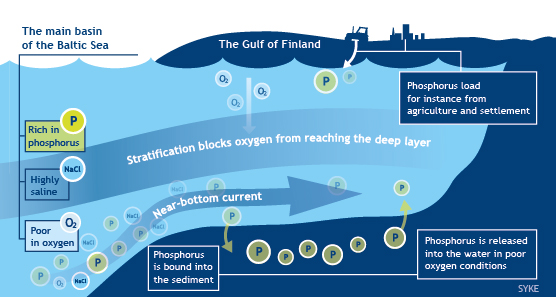Press release 2015-12-01 at 13:05

Cycle of Phosphorus in the Gulf of Finland © SYKE / Kaskas Media, Teemu Hotti
Algae levels and phosphorus load from land have decreased in the Gulf of Finland during the last ten years. However, the nutrients from Baltic Proper and the anoxic water near the bottom slow down the recovery of the Gulf of Finland from the long-term load. This is revealed in the extensive research and monitoring carried out by Finland, Estonia and Russia within the Gulf of Finland Year 2014 project.
During the year, the countries combined their water quality measurements in the Gulf of Finland from a period covering over 15 years into one database. The database provides information, for example, on oxygen content, nutrients and chlorophyll-a – which indicates algae levels – obtained from a total of 55 measurement points.
Currents and oxygen conditions slow down recovery
“The lowering of the algae levels is mainly due to wind changes, which regulate the circulation of nutrients through currents. In addition to this, reduced nutrient loads have also affected the algae levels,” Mika Raateoja, Senior Research Scientist at the Finnish Environment Institute (SYKE) says. “The reduction of nutrient loads from outside can best be seen in the eastern part of the Gulf of Finland, where emissions have been reduced the most, and where the Baltic Proper has a smaller impact compared to the western part.”
The phosphorus load to the Gulf of Finland has reduced greatly in 2004–2015, particularly due to the renewal of the urban waste water treatment system of St Petersburg. The discharge of phosphorus from the fertiliser factory in the River Luga was placed under control in spring 2012, which also contributed to the lowering of the load.
However, the situation of the Baltic Proper has slowed down the overall recovery process of the Gulf of Finland. The oxygen condition has deteriorated and the amount of phosphorus has increased in the deep basins of the Baltic Sea since the late 1990s. This anoxic and phosphoric water occasionally enters the Gulf of Finland, which has a notable impact on the condition of the Gulf. “The effect of nutrients from the Baltic Proper on the condition of the entire Baltic Sea is greater than we anticipated,” Mr. Raateoja says.
Research cooperation creates a more accurate image of the Gulf of Finland
The combined research and monitoring data of Finland, Estonia and Russia is also used as the basis of recommendations for actions targeted at the Gulf of Finland. The main recommendations are presented at the House of the Estates today, at the State and Future of the Gulf of Finland event. SYKE will also publish a Policy Brief on the same topic with viewpoints for decision-makers in environmental policy at the event. There are recommendations on both traditional themes, such as how to mitigate eutrophication and minimise risks in sea traffic, and new challenges, such as how to identify the sources of and find ways to reduce the amount of harmful substances, medicinal substances and microplastic litter.
“Thanks to the shared database, we have been able to assess the condition of the Gulf of Finland more extensively than before, taking into account the special features of the Gulf of Finland,” Kai Myrberg, Gulf of Finland Year 2014 Coordinator at SYKE says. “Importantly, the database contains an extensive set of measurements taken in Russian territorial waters. We have not had regular access to such data before. The project has also highlighted the importance of cooperation among all countries in the Baltic Sea region. No country can purify the Baltic Sea on its own.”
The Gulf of Finland Year 2014 was a joint programme between Finland, Estonia and Russia, the aim of which was to improve the condition of the Gulf of Finland. The project has increased awareness of the importance and urgency of protecting the Gulf of Finland and the Baltic Sea, and built understanding on the functioning of the sea.
Links:
Additional information at the SYKE Marine Research Centre
Mika Raateoja, Senior Research Scientist
tel. +358 (0)295 251 536, firstname.lastname@ymparisto.fi
Kai Myrberg, Leading Researcher and Project Coordinator for the Gulf of Finland Year 2014
tel. +358 (0)295 251 441, firstname.lastname@ymparisto.fi
Saara Reinimäki, Communications Expert
tel. +358 (0)295 251 613, firstname.lastname@ymparisto.fi